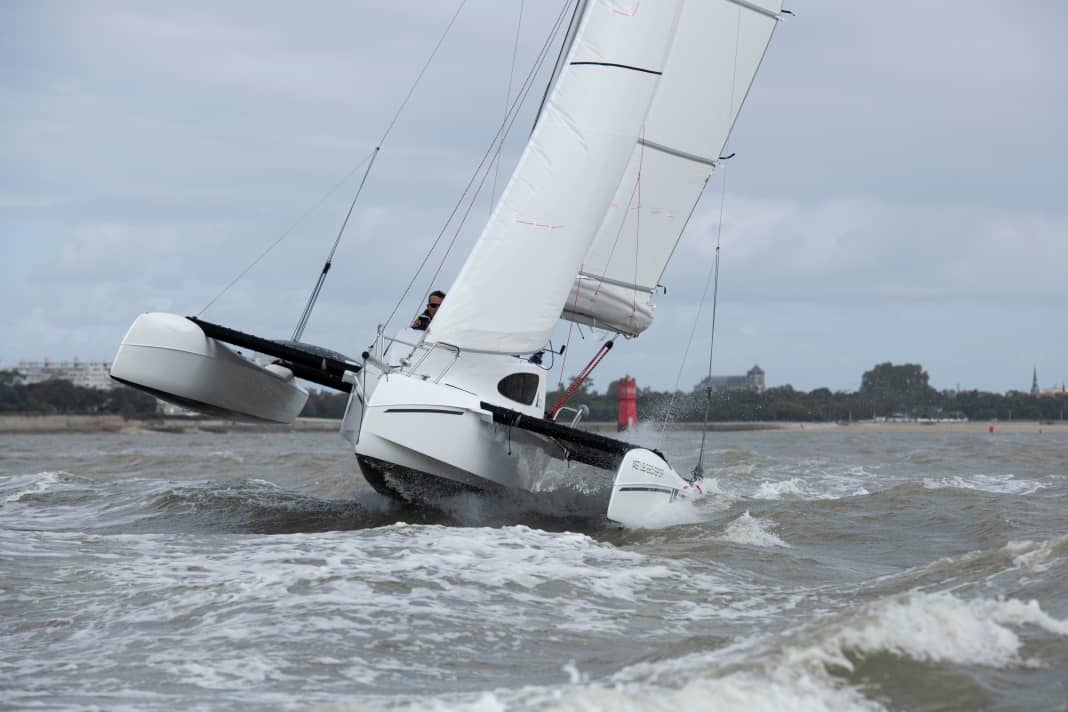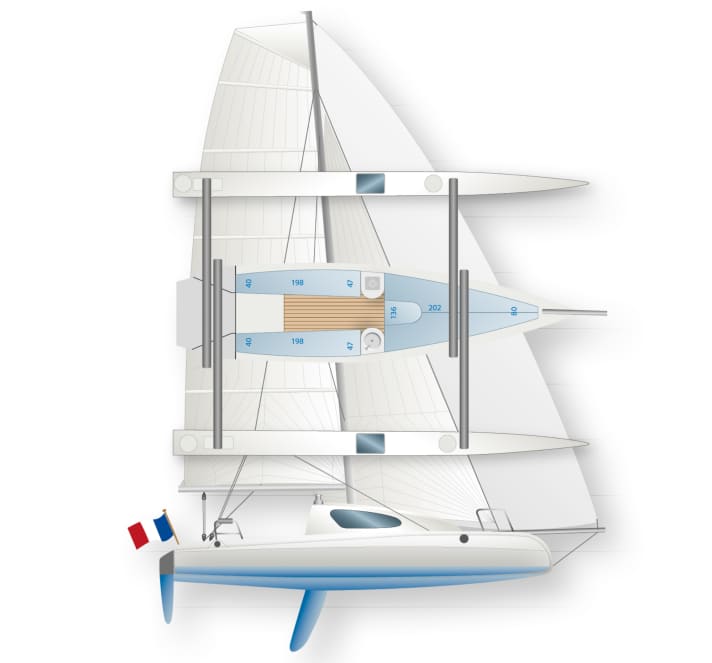





The range is modest and manageable: there are only a few small and trailerable trimarans that are also habitable. But the range is growing. In addition to the long-established brands such as Corsair Marine and Dragonfly, the younger French manufacturers Tricat and Astus are pushing into the niche. The space seems to be there: All are happy to see a steady increase in demand. This is understandable, as the handy three-hulls have a lot to offer: good performance, great fun potential, high flexibility. What's more, they are usually suitable for touring and even families - a mix of sports boat and small cruiser on three hulls, so to speak.
Unlike its competitors, who also implement the trimaran theme on a larger scale in their programme (Dragonfly up to 40 feet), Astusboats' range is limited exclusively to the compact format. The French shipyard's largest boat is the well-selling Astus 24 with a hull length of 7.40 metres (YACHT 13/2014 test). The latest model, the Astus 22.5 with a hull length of 6.90 metres, is expected to bring similar sales success.
Space-saving float concept
Every year, around 25 boats leave the production facility set up by Jean-Hubert Pommois in Brittany in 2004. He also came up with the technical concept of Astus and has stuck to it for all models ever since. Typical of the brand is the mechanism for less width in the harbour or for transport on the road. On an Astus-Tri, the outer floats are moved. The principle is very simple: the beams consist of solid horizontal aluminium tubes, which are arranged in a staggered arrangement and inserted into correspondingly larger fitting tubes that are integrated into the hull. On land, the floats are simply pushed parallel close to the centre hull or retracted on the water using a sheet pull and the winch.
Astus has this simple and favourable patent exclusively within the competition. In the trimarans of other providers, the floats are either folded in (Corsair) or swivelled backwards (Dragonfly, Tricat). However, this requires stable hinges or joints, which are complex to produce and install and therefore expensive; and the hull constructions must be reinforced accordingly. The disadvantage of the Astus system is that the trampolines have to be loosened to retract and extend the floats and tightened again for sailing to ensure that the process runs smoothly. For regular use, for example for harbour moorings, the Astus principle is therefore somewhat more cumbersome than competitor applications.
The Astus 22.5 is a VPLP design
The design for the new Astus 22.5 comes from the renowned VPLP Design office. It is well known that they know a thing or two about trimarans. Many of today's most successful ocean-going trimarans come from the same source. The strikingly slender side floats have a distinctive wave piercer design and are built higher, especially at the front, in order to provide sufficient buoyancy in swell. Equally striking is the pronounced chine in the plump centre hull over the entire length. This keeps the waterline slim, while still providing sufficient volume for an interior suitable for touring.
The test with the new Astus 22.5 takes place off La Rochelle, in very challenging conditions. The wind was blowing between 20 and 25 knots, and the draughty south-westerly wind was pushing a substantial wave of at least 1.5 metres into the bay. The small trimaran struggles with this, but still performs well in the test. A reef is quickly tied into the fully battened mainsail with a wide top, and the short overlapping genoa remains in place. Leading the Astus 22.5 hard into the wind is difficult in strong winds and high waves. The three short hulls quickly get stuck in the waves.
Turning becomes a challenge
However, if you open the sails just a little and let the boat run, the tripod surprises with good speed, sails stiffly and also gets through the waves without any problems. At an angle of 50 degrees to the true wind, the log registers an average of 7.1 knots. Although a furling gennaker is part of the test boat's wardrobe, it remains in the bag in view of the delicate conditions. Nevertheless, the Astus achieved double-digit speed values almost continuously on the downwind leg. The record on the test day: 14.2 knots, which is quite impressive for a small touring trimaran.
Tacking becomes a challenge in the high waves. Only after several attempts with the jib held back does the overstay manoeuvre work. Shipyard manager Jean-Hubert Pommois says that the manoeuvres run smoothly in less wind and flat water, which other Astus models have already proven in previous YACHT tests. The very high rudder pressure on the test boat is unpleasant. This is because the tiller of the rear-mounted rudder system is clearly too short, which is due to the guidance of the main bulkhead buoy. The shipyard is aware of this and wants to check whether the traveller rail for the series can be built further forward on the deck and thus the tiller can be longer. In addition, the centreboard box will be moved five centimetres aft in future, which should further reduce the rudder pressure.
Handling and living space
Otherwise, handling is straightforward. The main sheet buoy, traveller and genoa sheet are the important and only trimming devices underway. The genoa sheet is only led directly to the winch through an eyelet on the coachroof. What is definitely missing here is a short centreboard track or at least a furling system so that the sheet angle can be adjusted. The Sport version of the Astus 22.5 is also equipped with a bowsprit for a gennaker or Code Zero. The aluminium tube is anchored in a trough on the foredeck and is fixed in place with a water stay. An extendable trunk is not provided because the shipyard wants to do without hull penetrations so that no water can get into the boat. For the same reason, the pipes for the float insertion system are routed above deck in corresponding recesses.
The living space below deck is sufficient for a short and undemanding cruise with the family. Four people can sleep inside, and the shipyard offers two optional galley modules with a small cooker and sink. There is also space for a portable toilet. With a width of 1.36 metres at shoulder height, the sleeping area in the foredeck is not generous, but is large enough for two people to sleep. And it is larger than the berths on the Dragonfly or Corsair boats. On the other hand, the two sofa berths built far to the rear are a maximum of 47 centimetres wide and do not offer adults sufficient comfort.
This is how much the new Astus costs
With a base price of 52,360 euros, the Astus 22.5 costs about the same as the new Tricat 6.90, which is also the same size. This puts the two French boats in more direct competition with each other than with the somewhat larger trimarans from Corsair Marine or Dragonfly, which are also significantly more expensive.
You don't necessarily have to hammer through a choppy sea in force six winds to have a lot of fun with the new trimaran from Astusboats. There is no doubt that it can also impress in more moderate conditions. The concept is simple, good and does not need any frills. Ultimately, this is also reflected in the attractive price.
The Astus 22.5 in detail

Technical data
- CE design category: C
- Hull length: 6.90 m
- Total length: 8.30 m
- Waterline length: 6.85 m
- Width: 4.70 m
- Width reduced: 2.52 m
- Draught / centreboard raised: 1.40 m / 0.34 m
- Mast height above WL: 9.00 m
- Theoretical hull speed: 6.4 knots
- Weight: 720 kg
- Mainsail: 21.0 m²
- Jib: 9.0 m²
- Gennaker: 32,0 m²
- Motorisation: Outboard up to 9 hp
Sailing performance (without drift/current)
Wind speed: 20-25 kn (5-6 Bft), wave height: approx. 1.5 m
- 50°: 7.1 kn
- 60° : 7.9 kn
- 90° *: 8.7 kn
- 120° *: 11.7 kn
- 150° *: 8.4 kn
Sporty character. The Astus 22.5 is light in comparison and carries a lot of sail area.
Hull and deck construction
- Centre hull built as a GRP sandwich construction using the vacuum infusion process with foam core
- Side floats hand-laminated in GRP sandwich
- The beams are made of aluminium tubes
Rig and sail
Aluminium rig from Seldén with conventional trimaran rigging. The rig can be set and lowered by hand using a hinge at the foot of the mast. Simple dacron sails are included, a gennaker or code zero is available as an option
Additional foils
Astusboats offers catch-up, profiled C-foils in the side hulls as an optional extra. They are designed to provide more buoyancy, less drag and therefore a noticeable increase in performance
Equipment and prices
- Base price ex shipyard: € 52,360
- Price ready to sail: € 60,010
- Warranty/against osmosis: 2/2 years
Shipyard
- Astusboats, F-56400 Brech
- astusboats.com
Distribution
- Sport Mohr e. K., 23858 Reinfeld
- sportmohr.de
YACHT rating
Design and concept
- + Simple slide-in system
- + Proper construction
- + Trailer-compatible and slipable
Sailing performance and trim
- + Strong performance in the wind
- + Clear handling
- - Short tiller, lots of rudder pressure
Living and finishing quality
- + Touring suitability in modules
- + Large sunbathing area in the foredeck
- - Very narrow berths aft
Equipment and technology
- + Attached anchor locker
- + Foils as an option
- - Missing hole point adjustment

